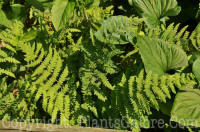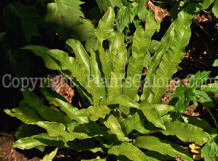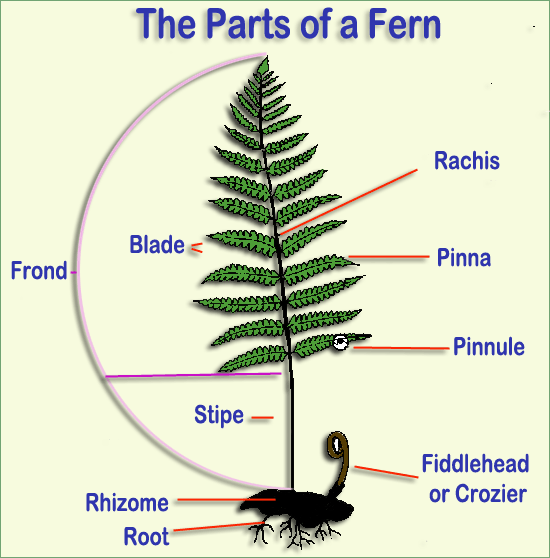 In the past few
decades, when people think of plants for the shaded
areas of their landscapes, they turn to
Hostas.
They are now the number one selling perennial in the
United States In the past few
decades, when people think of plants for the shaded
areas of their landscapes, they turn to
Hostas.
They are now the number one selling perennial in the
United States
However, this has not
always been the case and there are plenty of other
alternatives to use in the shade. Perhaps the more
traditional plant of choice is the fern. Believe it
or not, they are still out there and need to be used
more...if only as a textural contrast for hostas.
But then, I must confess that I am a
hostafile
myself.
|
|
 |
|
Uses for Ferns |
- Groundcovers
- Foundation Plantings
- Woodland Gardens
- Accents in Beds and
Borders
- Streamside Gardens
|
|
 |
Advantages of Ferns in the Landscape
|
-
 Season Long Interest
- The main point of interest with ferns is, of
course, their foliage. Unlike flowers that come
and fade quickly, foliage maintains its interest
throughout the season. From the fronds unfurling
in the spring to the hint of fall color, ferns
can provide a beautiful part of your landscape. Season Long Interest
- The main point of interest with ferns is, of
course, their foliage. Unlike flowers that come
and fade quickly, foliage maintains its interest
throughout the season. From the fronds unfurling
in the spring to the hint of fall color, ferns
can provide a beautiful part of your landscape.
-
Persistence - As
long as the ferns you use are rated for your
USDA Hardiness Zone, they should be a
fixture in your landscape for years to come. To
one degree or another, they will spread and fill
the area over time.
-
Problem Free -
Plant ferns in the environment that they like
and they are generally free of major insect or
disease problems.
-
Design Potential -
Ferns are strong plants but they are also
beautiful and contribute to your landscape
design. Their foliage is generally fine textured
and can be used to complement nearby coarse
texture plants such as large leaved
hostas. They
can perform the function of mass in large
groupings and variations in frond colors can
help highlight neighboring plants.
|
|
|
|
Disadvantages of Ferns |
-
 Invasiveness -
A few species spread by rhizomes meaning that they
can take over an area if left to their own devices.
Check this out before you buy and install ferns. Invasiveness -
A few species spread by rhizomes meaning that they
can take over an area if left to their own devices.
Check this out before you buy and install ferns.
A few ferns with a reputation for becoming invasive
would include bracken fern, (Pteridium aquilinum),
New York fern, (Thelypteris noveboracensis),
Old World climbing fern, (Lygodium
microphyllum) and Japanese climbing fern, (Lygodium
japonicum). Of course there are others so check
them out.
-
pH Requirements -
Since they are generally native to woodland areas,
many ferns prefer an acidic soil although they will
tolerate a wide range. Soils with a pH well above
neutral (pH 7.0) may need to be acidified.
-
Propagation -
Ferns are not seed producing plants. Rather, they
reproduce through an organ called a spore.
Propagating ferns using spores can be an interesting
process for the backyard gardener.
|
|
 |
Structure of Ferns
|

|
The typical fern found in home landscapes would
include the following parts which may usually be
used as traits for identifying the different
species.
-
rhizomes - A
rhizome is an underground stem also found in
Iris and quackgrass. It acts as the link between
the roots which draw moisture and nutrients from
the soil and the fronds which carry out
photosynthesis. In ferns, the rhizome accounts
for the particular growth habit of the fern i.e.
whether it is an upright, creeping or other
form.
-
Croziers or Fiddleheads
- These are the first structures you see in the
spring as the new fronds are beginning to
emerge. They resemble the head of a violin and,
depending on how they unwind, they can be used
to identify the species.
-
Frond - What would
be called a compound leaf in seed bearing plants
is called the frond on ferns. That is the term
for the entire structure which is made up of:
-
Stipe - This is
the segment of the "stem" of the frond that
emerges from the underground rhizome and has
no structures growing from it. It can be a
few inches or several inches in length.
-
Blade - Located
above the stipe, the blade is made up of the
supporting stalk called the rachis and the
"leafy" structures called a pinna (pinnae in
plural). Even smaller units called pinnule
combine to make up the pinna.
-
Coverings - The
frond may also have structures called hairs
or scales which help protect it. The
presence or absence of hairs or scales can
be help identify a species of ferns.
|
|
 |
|
Frond Types |
Similar to leaves on seed bearing plants, ferns also
have various configurations for the way their parts
are arranged. Instead of leaf blades, in ferns, we
talk about frond parts. Again, this particular
characteristic is one that is used to help identify
the species of fern.
The term most
commonly used to describe the difference in fronds
is dissection. Generally, this means the peaks and
valleys of the frond. In leaves, we call them lobes
and distinguish them by how deep the lobe goes
toward the midrib (the rachis in ferns).
Fern fronds can be
categorized as follows:
-
Simple - These
fronds are undissected i.e. have no lobes.
-
Pinnate - The blade
(pinna) is divided once completely to the stem
(rachis) where it is narrowed at the point of
attachment or is stalked.
-
Bipinnate - The
blade (pinna) is divided twice. Once where the
tiny pinnules attach to the rachis of the pinna.
Second where the pinna attaches to the main
rachis.
-
Tripinnate and
Quadripinnate -
Further dissection of the parts of the frond.
-
Pinnatifid - This
is when there is a partial dissection of the
pinna or pinnule where the dissection does not
go all the way to the main rachis or the rachis
of the pinna.
|
|
 |
|
Reproductive Fronds |
Fern fronds are also categorized by the type of
reproductive tissue they contain.
- Infertile Fronds
- The first fronds produced in the spring by
many ferns are sterile.
- Fertile Fronds
- These fronds bear the sporangia which are the
spore producing organs of the fern. A cluster of
sprangia are (for some reason) called a son.
These groups may be round, oblong or linear in
shape and may be covered by a thin mantle layer
called the indusium (plural is indusia).
Fertile frond usually unfurl later in the
spring. However, to the untrained eye, they may
be confused with the sterile fronds.
a. Fertile fronds are
identical to the sterile frond. Ex. Lady
Fern (Athyrium filix-fernina)
b. Fertile fronds are
similar to the sterile frond. Ex.
Interrupted Fern (Osmunda clatoriana)
c. Fertile fronds are entirely different from
the sterile frond. These are called dimorphic
fronds. Ex. Ostrich Fern (Matteuccia
struthiopteris)
|
|